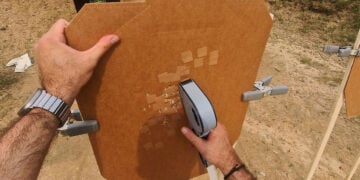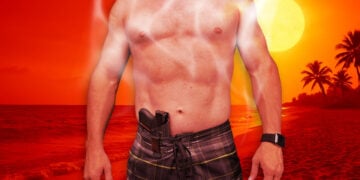Apparently, Jeff Cooper was once asked why he was afraid to go unarmed. He answered in a most articulate and witty fashion, as was his usual, and stated roughly, “I am not afraid to go unarmed, but I find it indignant.” If you are a concealed carrier, you probably find traveling to places where you must be unarmed “indignant” as well. I often travel to places where I can’t be armed with a firearm, and I truly find it indignant. I cannot fathom how the majority of people who live in such places within the United States keep the status quo in such localities. Being forcibly disarmed while the criminal element runs wild is the exact opposite of dignity, in my opinion, but that is how such folks like to live. Unfortunately, those of us who believe in being armed, among other forms of basic human dignity, must often go to such places.When disarmed of a handgun, what are the alternatives for carrying at least some form of personal protection? This question is also based entirely on what the law codes are in the vicinity being traveled to. Many will propose that any such limitations are not constitutional and such laws should be ignored, but here we will seek to work within the limitations of the law, despite how preposterous they are. When we do not have the option of legally carrying a pistol for personal protection, as the vast majority of people within the United States can legally do, what are the alternatives? What tools can we carry for self-defense and general preparedness, even though such tools may be a poor substitute for the handgun?Domestic vs. International Travel Considerations
The first consideration when thinking through alternate defensive tools is whether your travels will be within the United States or abroad. The majority of the US is far less restrictive on what an individual can carry compared to most of the world. In many foreign nations, the carry of blades, impact weapons, and even pepper spray is forbidden. Within the United States, the most restricted places in this regard are the known big, politically blue cities that revel in disarming their citizens in the midst of endless crime pandemics. The majority of the United States, however, is more liberal in such personal freedoms than these blue holdouts or the rest of the world. Therefore, if traveling internationally, know the laws where you will be visiting.In general, international destinations are far more restricted than anything within the United States. Even a folding knife, which is legal almost anywhere in the US except New York City, is forbidden for carry overseas. Generally, knives can be placed in checked baggage and legally brought along to most places, but carry of a blade is restricted in most vicinities. Know the laws before departing. Likewise, most international destinations will even restrict the carry of OC spray or severely limit the amount that can be legally carried. Know the regulations where you travel, and always go on the assumption that the destination wants you completely disarmed, as is the reality in most of the world.Options for United States Travel
When traveling to states that do not honor your carry permit, verify the legality of your alternate tools. For example, places like New York City restrict even common folding knives, but most of the country does not restrict the carry of small folding blades. Knife laws, in general, are convoluted as many localities, even within the same state, will have different ordinances in place regarding knife carry. Fixed-blade knives, while generally a better self-defense tool compared to a folder, are more restricted in more places. If you do your research and verify that a folder is legal at your destination, certainly having a knife is better than having no defensive tool at all, though I urge people who rely on blades as a defensive tool to seek out training. Deploying a knife, a folder in particular, in a fight is no easy task.
A very good tool that can be carried in most places within the United States is OC (pepper) spray. OC is a less-lethal tool that concealed carriers should always have anyway, as it is a tool for dealing with “simple assault” rather than deadly assault. Still, if unable to carry your gun, having OC spray on you is a very good idea. Many forms of violence start with a criminal actor trying to close distance and make contact, and OC spray can be used to short-circuit this approach and give you the opportunity to evade the aggressor. While hardly a replacement for a firearm, OC spray is imminently useful for dealing with the far more likely simple assault situation, and it should be carried at all times, regardless. There are few localities that restrict OC spray within the United States, and carrying it with you, even when disarmed of your handgun, is a sound decision.Options for Traveling AbroadTwo tools that can go almost anywhere in the world with you are items that you should always carry daily, even when carrying your gun; a flashlight and a medical kit. When traveling internationally, these are the tools that I bring. I opt for a powerful flashlight, but one with no aggressive bezel features, such as those designed to make striking more effective. First of all, such sharp edges on the bezel does nothing to enhance the impact of a blow with a flashlight anyway, and such features can draw attention as a flashlight can be viewed as a weapon due to these unnecessary features. A high-lumen light that is robustly built, but has no striking specific features, is a great tool that can go almost anywhere in the world because it is, after all, only a flashlight. A very bright light in someone’s eyes in the dark is a dissuasive element that can provide a significant advantage. Again, internationally or domestically, always carry a good light, and do so whether also carrying a gun or not.Medical gear can also go almost anywhere and should be carried on a daily basis, even when armed with your firearm. When traveling internationally, I keep a trauma kit in my backpack or whatever bag I am carrying, and I usually have at least a tourniquet on my person. One point of note is this; carry a true windlass tourniquet such as a CAT or SOFT-T Wide. There have been reports of the bungee cord-type tourniquets being confiscated and raising suspicion as drug paraphernalia. A real tourniquet is easy enough to identify as such, should it raise any eyebrows, to begin with. Also of note, medical shears can go to most places as well, even on an airplane, though they can get confiscated. If you have a pair of shears in your trauma kit when traveling, use the cheap ones, as you don’t want your specialty shears that were expensive getting confiscated.Traveling unarmed is no fun for most of us that conceal carry every day, but that is the reality of this world. While there is no substitute for a handgun, having some tools available rather than nothing is always an advantage, and carrying such preparedness tools as a light and medical kit should be part of our daily routine anyway, regardless of the gun we may or may not have.










